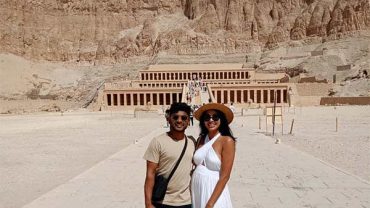Nestled along the serene waters of the Nile River in Upper Egypt lies the majestic Philae Temple, a testament to the grandeur of ancient Egyptian architecture and religious significance. The Philae Temple, dedicated primarily to the goddess Isis, stands as an iconic symbol of devotion and cultural richness. Its enduring allure transcends time, inviting visitors to embark on a journey through the annals of history and immerse themselves in the mystique of ancient Egypt.
Historical Significance
The Philae Temple, dating back to the Ptolemaic period and later expanded during the Roman era, serves as a tangible link to the religious practices of the time. The complex is an intricate fusion of Egyptian and Greco-Roman architectural styles, showcasing the cultural syncretism prevalent during its construction. Dedicated to the worship of Isis, Osiris, and Horus, the temple complex played a pivotal role in the spiritual life of ancient Egyptians. Pilgrims from far and wide would make the arduous journey to pay homage to these deities, seeking blessings, healing, and divine guidance.
Beyond its spiritual importance, Philae Temple has a captivating history, marked by the intricate relocation process it underwent in the 20th century. With the construction of the Aswan High Dam, threatening submersion, UNESCO spearheaded a monumental effort to rescue and relocate the temple to the nearby Agilkia Island. This painstaking endeavor preserved not only the physical structure of the temple but also the intangible cultural heritage encapsulated within its walls.
Architectural Marvels
The Philae Temple stands as a remarkable testament to the architectural prowess of ancient Egyptian builders. The intricate carvings, colossal statues, and imposing pylons reflect the meticulous craftsmanship of a bygone era. The main entrance, adorned with towering pylons, welcomes visitors with scenes depicting the divine rituals and mythological narratives. As one traverses through the temple complex, the Hypostyle Hall captivates with its towering columns adorned with detailed reliefs narrating the stories of the deities.
One of the most awe-inspiring features of the Philae Temple is the grandiose Isis Temple, positioned prominently within the complex. Dedicated to the goddess Isis, this sanctuary exudes an aura of sacredness, with its inner sanctum housing a venerated cult image. The island setting enhances the overall ambiance, providing a picturesque backdrop to the architectural splendors of the temple. Philae’s architectural marvels not only evoke admiration for the skills of ancient builders but also offer a tangible connection to the religious and cultural milieu of ancient Egypt.
Cultural Significance Today
In the modern era, Philae Temple continues to be a cultural touchstone, drawing scholars, historians, and tourists from around the globe. Its designation as a UNESCO World Heritage Site underscores its universal importance. Visitors today can explore the temple complex, marveling at the rich tapestry of Egyptian history woven into its stones. The site’s cultural significance extends beyond its historical narrative; it serves as a living testament to the enduring legacy of ancient Egypt, fostering a deeper understanding of the roots of human civilization.
Philae Temple’s enduring allure is not only in its physical grandeur but also in the stories it whispers to those willing to listen. As visitors walk in the footsteps of ancient pilgrims and gaze upon the timeless carvings, they become part of a continuum, bridging the past and the present. Philae Temple stands not merely as an archaeological relic but as a vibrant cultural beacon, illuminating the path to a richer appreciation of the diversity and depth of human history.
Spiritual Significance
Philae Temple’s spiritual resonance echoes through the ages, transcending the boundaries of time and space. Dedicated primarily to the goddess Isis, the temple served as a locus for ancient Egyptian religious practices, offering a sacred haven for devotees seeking divine intervention. The intricate reliefs adorning the temple walls depict religious ceremonies, mythological tales, and the divine lineage of the ancient pantheon. Pilgrims would undertake arduous journeys, drawn by the belief that the sacred aura surrounding Philae Temple held the key to blessings, healing, and spiritual enlightenment.
The reverence for Isis, Osiris, and Horus permeated every corner of the temple complex, creating an immersive spiritual environment. The rituals conducted within the hallowed halls were believed to forge a connection between the mortal realm and the divine. The echoes of ancient prayers linger in the sanctuaries, providing a glimpse into the profound spiritual experiences that unfolded within these sacred precincts. Today, as visitors explore Philae Temple, they have the opportunity to tap into this spiritual legacy, connecting with the profound sense of devotion that once filled its chambers.
Relocation and Preservation
The saga of Philae Temple extends beyond its ancient origins to a remarkable tale of preservation and resilience in the face of modern challenges. The construction of the Aswan High Dam in the mid-20th century posed a significant threat to the temple, as the rising waters of Lake Nasser threatened to submerge this architectural marvel. Recognizing the urgency of the situation, an international effort led by UNESCO orchestrated the meticulous relocation of Philae Temple to Agilkia Island.
This monumental undertaking involved disassembling the temple piece by piece and reassembling it on higher ground, ensuring its protection from the encroaching waters. The relocation not only safeguarded Philae Temple from the destructive forces of progress but also preserved its authenticity and integrity. Today, visitors can witness not only the architectural splendor of the temple but also appreciate the dedication of those who rallied to protect this cultural gem for future generations. The relocation of Philae Temple stands as a testament to humanity’s commitment to preserving its heritage, even in the face of modern challenges.
Tourist Experience
Philae Temple’s allure extends beyond its historical and spiritual dimensions to offer a captivating experience for modern-day tourists. As visitors step onto the shores of Agilkia Island and approach the temple complex, they are greeted by a harmonious blend of natural beauty and architectural magnificence. The tranquil waters of the Nile surround the island, creating a serene backdrop for exploration.
Guided tours provide insight into the historical and cultural significance of Philae Temple, unraveling the mysteries encoded in its carvings and structures. The well-preserved reliefs and statues offer a tangible connection to the beliefs and practices of ancient Egyptians, making the visit not just an educational experience but a journey through the annals of human civilization. Philae Temple stands as a living testament to the power of heritage tourism, inviting visitors to not only witness history but to become a part of the ongoing narrative that Philae continues to tell.




Comment (0)